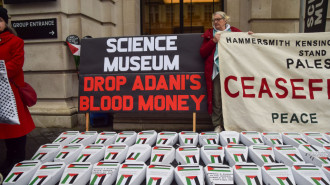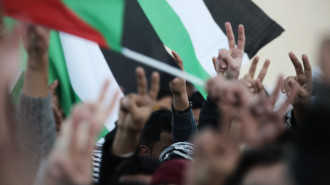
Abandoned to their fate: Children die from hunger and disease in Syria's Al-Hol camp as world turns its back

Dozens of children in the Al-Hol camp in northeast Syria, an area under the control of the Syrian Democratic Forces (SDF), are dying as a result of the appalling camp conditions and a lack of the most basic safeguards or medical care.
Hunger and disease are the primary killers, with child camp residents growing up in a deeply unsafe environment, the harsh realities of which have been revealed by residents and workers from the international organisations present in the camp.
Last April, Zayneb Al-Assi fled with her three children from the Al-Hol camp, which is situated to the south of the Al-Hol village in the Al-Hasakah province, by hiding in a water tanker as it left the camp. The family managed to secure a ride by paying $5,000 to a smuggler, which he divided between himself and the SDF camp guards.
"Dozens of children in Al-Hol camp in northeast Syria, an area under the control of the Syrian Democratic Forces (SDF), are dying as a result of the appalling camp conditions and lack of the most basic safeguards or medical care"
The journey lasted four and a half hours and the children almost suffocated, Zayneb reveals. However, she says their desperation to escape from "the death by hunger or disease which stalks children in the camp" led her to take the risk.
There are around 62,000 people living in the Al-Hol camp, approximately two-thirds of them children. Nearly 50 percent of the camp's residents are Syrians. Fabrizio Carboni, Regional Director of the International Committee of the Red Cross (Near and the Middle East) visited the camp in July 2021. He said to Al-Araby Al-Jadeed, The New Arab's Arabic-language sister publication, that living conditions in the camp were "extremely difficult" and there were high levels of medical need.
What is the child mortality rate in the camp?
The International Rescue Committee (IRC) revealed in a report from September 2019 that 339 child deaths were recorded between December 2018 and September 2019. Save the Children subsequently released a report on 23 September 2021 which recorded the deaths of 62 children in the Al-Hol camp in 2021 alone, at a rate of two children every week. According to UNICEF, 99 children died at the camp in 2020 and 2021.
Residents and workers in the camp put the high rate of child fatalities down to different causes. For instance one receptionist (who preferred to remain anonymous) at the Kurdish Red Crescent clinic in the camp said during the first four months of 2021 she had witnessed 10 newborn babies die shortly after birth. Huda Shammar, a Syrian who left the camp in September 2020, says that while living in the camp, three children in the tent next to hers died within two months, one in a fire and two from disease.
Why are children dying in Al-Hol?
Carboni believes the child deaths are mainly due to the high incidence of disease and inadequate medical care in the camp. Severe malnourishment is a huge issue: an ICRC survey at the end of 2020 showed that 16 percent of children surveyed were severely malnourished.
This is consistent with a report by the IRC, which linked the high number of child deaths to complications arising from severe malnutrition, diarrhoea leading to dehydration, and pneumonia, all of which indicate the poor health conditions and lack of humanitarian aid in the camp.
"The lack of sufficient nutritious food for every child, the lack of staff with experience dealing with malnutrition, the delay in diagnosing diseases, and the lack of medicines, are all factors leading to child deaths"
The highest number of deaths among children younger than five were in what is known as the annex (a fenced-off section for non-Syrian and non-Iraqi wives or widows of Islamic State fighters and their children). Access to medical services in the annex is even more restricted than in the rest of the camp, and 34 percent of child deaths in the camp before July 2019 were of children in this section.
The most recent Save the Children report showed similar findings but also noted that fires are another major cause of death, after 13 children died in fires that broke out in the camp in 2021. Recurring fires in Al-Hol camp are more evidence of the utter deterioration in living conditions in the camp and how these impact children directly, says Iman Traboulsi, spokesperson for the ICRC (Near and Middle East). She mentions a fire in February 2021 which killed eight people and injured tens of others, many of them children. In September 2020, a child died when their tent was set alight by a gas stove being used for heating.
Dr Mohammed Makhlouf, who oversaw the malnutrition section at UNICEF's medical point in the camp from 2019 until mid-2020, says the lack of sufficient nutritious food for every child, the lack of staff with experience dealing with malnutrition, the delay in diagnosing diseases, and the lack of medicines, are all factors leading to child deaths. He says the majority of deaths are due to acute malnutrition and diarrhoea.
Alian Abu Fadi has been detained in Al-Hol camp since he and his family were displaced from the town of Baghouz during the SDF offensive (on Islamic State's final stronghold in 2019). On the issue of healthy food provision in the camp, he reiterates the above, saying residents only receive a monthly food basket which contains no eggs, milk, fruit, vegetables or meat. Moreover, a carton of 14 eggs at the camp market costs 14,000 Syrian lira (around $5), which he and most families cannot afford.
Lack of specialists and medicines
Only three specialist doctors work in the field hospital inside the camp, run by ICRC in partnership with the Syrian Arab Red Crescent: an internal medicine specialist, a gynaecologist, and a paediatrician. They work with nurses and volunteers, according to Carboni, who stresses that the medical needs are vast and include maternal and child health care, surgery, mental health and physical rehabilitation.
Zayneb says her children's health declined in the camp due to the lack of doctors and medicines. One of her daughters suffered from a brain atrophy and an acute ear infection which worsened due to the lack of medical treatment. Two of her children suffered from chronic ear infections, respiratory and urinary tract infections, and diarrhoea, but whenever she took them to the medical points in the camp all they were given were painkillers and antipyretics along with a prescription for unavailable medicines.
"Doctors at the different medical points prescribe medicines despite knowing they’re not available or even permitted for sale in the camp pharmacies. As a result, many in the camp resort to the black market to obtain medicines"
Hamad Abdul Khaliq, an Iraqi who left Al-Hol in April 2021 concurs: "Doctors at the different medical points prescribe medicines despite knowing they’re not available or even permitted for sale in the camp pharmacies."
As a result, many in the camp resort to the black market to obtain medicines, by paying water tanker drivers who arrange for medicines to be smuggled into the camp in exchange for money. One of Zayneb's relatives had to pay a water tanker driver $40 to smuggle in kidney medicine for her monthly as she suffered from Hydronephrosis (swollen kidneys).
Medical transfers need months
Kamel Hashim (not his real name) works as an administrator at the Kurdish Red Crescent hospital, and explained that the medical centres in the camp provide emergency treatment and primary care, whilst to receive specialist, longer term treatment, patients need to obtain referrals to hospitals in Al-Hasakah or Qamishli.
Obtaining a transfer for treatment in a hospital outside the camp is "suffering itself" according to Ikram Abdul Wahid (not her real name), a widow from Baghouz. She says she has been waiting for three months with no result to have her child transferred - they have brain atrophy and suffer from acute seizures.
In 2021, 74 children died in Syria's Al-Hol camp, including eight who were murdered, according to Save the Children.https://t.co/2WfE8U2Ehj
— The New Arab (@The_NewArab) March 23, 2022
A regional coordinator (who asked not to be named) for the Kurdish Red Crescent Hospital in Al-Hol camp acknowledges there is a big problem with transferrals because priority is given to emergency cases, while non-emergency cases are transferred to a waiting list which might contain up to 500 names. Abdul Wahid says she has heard of many forced to pay bribes of up to $1,000 to obtain transfers.
Polluted water spreading diseases
Sheikhmous Ahmed, co-head of the office for internally displaced persons and refugees of the Autonomous Administration of North and East Syria (AANES), says that the water in Al-Hol is not fit to drink. This has been the case since October 2019 when the Allouk water station in Al-Hasakah stopped pumping water to the camp due to armed clashes with Turkey, and water is currently brought in by unmonitored water tankers, from Khatuniyah, Sadd and Tnin lakes in Hasakah.
Dr Makhlouf links the lack of clean water with the spread of diarrhoea and cases of acute dehydration. Zayneb confirms that her children suffered with diarrhoea continuously before they escaped the camp and gained access to clean water once more, when the diarrhoea stopped.
Alian Abu Fadi also mentions the lack of a sewage network – sewage channels flow close to the tents, and the use of communal toilets is also a factor in the rampant spread of disease: for every 24 tents, there are only six toilets.
Who is responsible?
Khaled Ibrahim, head of the Affairs Office of AANES, holds the organisations operating in the camp and the UN Office for the Coordination of Humanitarian Affairs (OCHA) responsible for the chaos in the camp which stretches to the medical services provided, saying: "They don’t let us monitor their activities."
However, the organisations hold AANES responsible. A statement from Doctors without Borders on 2 March 2021 pinned responsibility for the unsafe conditions to the local authorities who ultimately govern the camp and provide the security services. Kirsty Cameron, IRC's Regional Media Manager for the Middle East and North Africa explains that their access to the camp requires permission and approval from the camp authorities, as they hold responsibility for the camp.
"International organisations have poured in huge amounts of funding, however this has not translated into services being provided on the ground"
On aid into the camp, Dr Makhlouf says: "International organisations have poured in huge amounts of funding, however this has not translated into services being provided on the ground."
He says two types of organisations work in the camp, the first in cooperation with the Syrian government, (including UNICEF, the WHO, the UN Population Fund, the UN Development Programme, and UNHCR) and these have yearly budgets which they offer to their partner, and the second group are organisations which entered the area and the camp in cooperation with AANES.
This is an edited translation from our Arabic edition. To read the original article click here.
Original article published on 20 December 2021
Translated by Rose Chacko



